|
Caveat for users The AIHW is reviewing its methods for producing updated estimates, integrating recent data developments, improved data availability, and reviewer feedback. This includes adopting a new method for estimating expenditure on pharmaceuticals and an enhanced approach for estimating hospital expenditure. Additional time trend estimates are also being produced. Updates to the measure are anticipated for publication in 2025. |
Key messages
- Between 2010–11 and 2019–20, Australian Government health expenditure per person for Aboriginal and Torres Strait Islander people increased by 7.3% per year in real terms, from $2,269 to $4,295 per person (excludes expenditure on medications).
- Expenditure by the Australian Government on health services tailored to the needs of Indigenous Australians increased from $703 million in 2010–11 to $972 million in 2019–20, a growth in real terms of 38%.
- In 2019–20, the average health expenditure per person for Indigenous Australians was 1.5 times as high as for non-Indigenous Australians.
- MBS expenditure for Indigenous Australians was 1.2 times the rate for non-Indigenous Australians ($1,176 and $978 per person, respectively), in 2019–20.
- In 2019–20, expenditure on primary health care services for Indigenous Australians was $3,887 per person, compared with $2,055 per person for non-Indigenous Australians (ratio 1.9). Expenditure for secondary/tertiary health care services was $5,347 per person for Indigenous Australians, compared with $3,951 for non-Indigenous Australians (ratio 1.4).
- Primary health care expenditure on medical services, including those paid through the MBS, was $608 per person for Indigenous Australians, compared with $382 for non-Indigenous Australians (ratio 1.6).
- Expenditure on community health services was 3.5 times the rate for Indigenous Australians than for non-Indigenous Australians ($1,270 compared with $367 per person).
- In 2019–20, for Indigenous Australians, expenditure on hospital services was 3.9 times the expenditure for medical services (for example, MBS services provided by a medical practitioner), compared with 2.4 times for non-Indigenous Australians.
- In 2019–20, expenditure on potentially preventable hospitalisations totalled $499 per person for Indigenous Australians, compared with $208 per person for non-Indigenous Australians. Potentially preventable hospitalisations due to diabetes accounted for the largest difference (a gap of $48 per person), followed by chronic obstructive pulmonary disease (a gap of $33 per person), influenza and pneumonia (a gap of $28 per person).
- The Australian Government Department of Health’s Indigenous Australians’ Health Programme (IAHP) Economic Evaluation Phase One found that higher attendance at ACCHSs reduced the likelihood of hospital admission, as well as providing health gains.
- NACCHO, in partnership with Equity Economics, undertook an analysis of the gap in health expenditure for Aboriginal and Torres Strait Islander people. This report concludes that there remains a large and persistent gap in expenditure on health care for Aboriginal and Torres Strait Islander people given the additional need.
- Investing $1 in primary care in remote Aboriginal and Torres Strait Islander communities was found to save $3.95–$11.75 in hospital costs, in addition to benefits for individual patients. High levels of primary care utilisation were associated with decreases in avoidable hospitalisations, deaths and years of life lost.
Why is it important?
A basic principle of equity is that health expenditure should reflect the relative needs for health services (Braveman & Gruskin 2003; Whitehead 1991). Health expenditure for population groups with higher levels of need should be proportionately higher. A broad assessment of how well this principle is implemented is provided by comparing differentials in health status with differences in per capita health expenditure.
Health expenditure is defined as spending on health goods and services by all levels of governments as well as non-government entities such as individuals, private health insurers, and injury compensation insurers, which includes hospitals (both public and private); primary health care (unreferred medical services, dental services, other health practitioners, community health, public health, and medications); referred medical services; other services (patient transport services, aids and appliances, and administration); research; and capital expenditure (AIHW 2023).
The objective of the health care system is to meet the health care needs of the Australian population and produce positive health outcomes not only for individual Australians but also for the population as a whole. Expenditure is one measure of the needs met. It does not tell us about the unmet need (gaps) or the quality, appropriateness, cultural safety or responsiveness of care.
Four interacting factors within Australia’s health system potentially have major consequences for the health of many Aboriginal and Torres Strait Islander people, namely limited Indigenous-specific primary health care services; Indigenous Australians’ underutilisation of many mainstream health services and limited access to government health subsidies; increasing price signals in the public health system (such as co-payments) and a low Indigenous private health insurance rate; and failure to maintain real health expenditure levels over time (Alford 2015).
Data findings
This measure presents information on health expenditure for Aboriginal and Torres Strait Islander people, with the exception of expenditure on medications as this information is not currently available by Indigenous status (Box 3.21).
Total health expenditure (excluding medications)
In 2019–20, excluding expenditure on medications, the total health expenditure for Indigenous Australians was estimated to be $8,131 million, contributing to about 4.9% of the national health expenditure. An estimated 80.7% of funding used to pay for health-related goods and services for Indigenous Australians was from Australian governments (36.1% state and territory and 44.6% Australian Government) (Table D3.21.2). The average health expenditure per person for Indigenous Australians was estimated to be $9,619. Of this, over half (55%, $5,244) was spent on hospital services – consisting of $4,244 per person for public hospital services (44%), with $999 per person (10%) for private hospital services. Community health services accounted for 13% of health expenditure for Indigenous Australians ($1,270 per person) and Medicare services for 12% ($1,162) (Table D3.21.1).
Australian Government expenditure
During 2019–20, the Australian Government’s health expenditure for Indigenous Australians was $4,295 per person. Of this amount, 21% ($919 per person) was spent on Aboriginal Community Controlled Health Services (ACCHS), while 13% ($569) was allocated to the MBS (Table D3.21.4).
Expenditure by state and territory
In 2019–20, state and territory government health expenditure for Indigenous Australians was $5,328 per person. Of this amount, 45% ($2,414 per person) was spent on admitted patient services in public hospitals, and 19% ($1,004 per person) on community health and public health services (Table D3.21.4).
Estimated expenditure per person for Indigenous Australians by state and territory governments (before offsetting states’ revenue from Australian Government and non-government sources) is the expenditure provided by each state and territory divided by their estimated resident population.
Estimated expenditure varied across jurisdictions. In 2019–20, total health expenditure ranged from $11,082 per person in the Northern Territory to $3,027 per person in Tasmania (Table D3.21.3, Figure 3.21.1). The variation between jurisdictions may be explained in part by differences in the proportion of Indigenous Australians within each jurisdiction living in remote areas.
Figure 3.21.1: State and territory health expenditure per person for Indigenous Australians, by jurisdiction, 2019–20
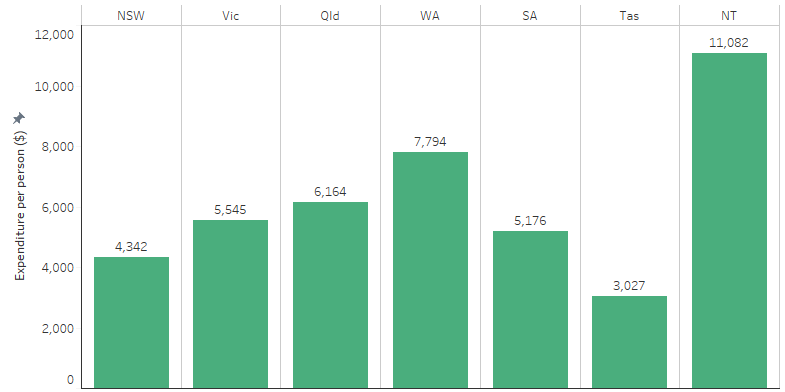
Source: Table D3.21.3 AIHW Health Expenditure Database.
Expenditure by remoteness
In 2019–20, expenditure estimates by remoteness were produced for expenditure on admitted patient care, MBS, and Australian Government Department of Health and Aged Care grants to Aboriginal Community Controlled Health Services. In 2019–20, total expenditure per person on these selected health services for Indigenous Australians was $9,374 per person in Remote and very remote areas, $5,166 per person Inner and outer regional areas, and $4,797 per person for Major cities (Table D3.21.7, Figure 3.21.2).
Figure 3.21.2: Health expenditure per person for Indigenous Australians on selected health services, by remoteness area of patient’s residence, 2019–20
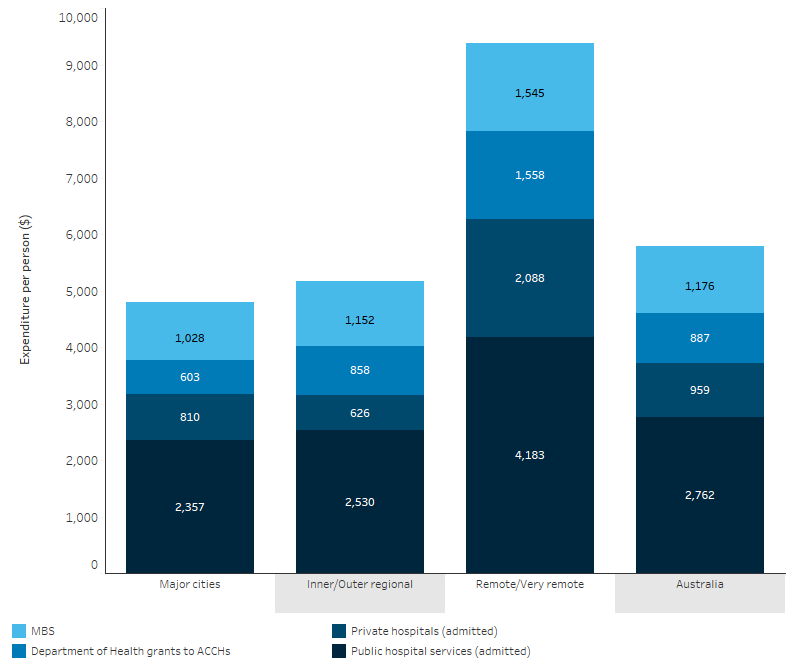
Note: Excludes health expenditure on non-admitted patient services, patient transport, dental services, community health services other than ACCHSs, other professional services, public health services, aids and appliances, research and health administration. Also excludes expenditure on medications.
Source: Table D3.21.7. AIHW Health Expenditure Database.
Expenditure on Medicare Benefits Schedule
In 2019–20, total MBS expenditure per person for Indigenous Australians was $1,176. Across remoteness areas, per person MBS expenditure for Indigenous Australians increased with remoteness, ranging from $1,028 per person for those living in Major cities, $1,152 per person for those in Inner and outer regional areas and $1,545 per persons for those living in Remote and very remote areas (Table D3.21.8, Figure 3.21.3).
Figure 3.21.3: MBS expenditure per person for Indigenous Australians, by remoteness area of patient’s residence, 2019–20

Source: Table D3.21.8. AIHW Health Expenditure Database.
Primary and secondary/tertiary health services
In 2019–20, $3,286 million and $4,520 million were spent on health expenditure on primary and secondary/tertiary health services for Indigenous Australians, respectively (Table D3.21.5). That was equivalent to $3,887 per person on primary health services, and $5,347 per person on secondary/tertiary health services (Table D3.21.6).
Total hospital expenditure (including admitted and non-admitted patient services) is the largest single expenditure item in secondary/tertiary health care services for Indigenous Australians, accounting for $4,328 per person. Expenditure on secondary and tertiary care medical services was estimated to be $725 per person for Indigenous Australians (Table D3.21.6, Figure 3.21.4).
For health services tailored to the needs of Indigenous Australians, the Australian Government spent $972 million on Indigenous-specific health programs through the Department of Health in 2019–20 (Table D3.21.9).
Figure 3.21.4: Top 5 areas of health expenditure per person on primary and secondary/tertiary health services for Indigenous Australians, 2019–20
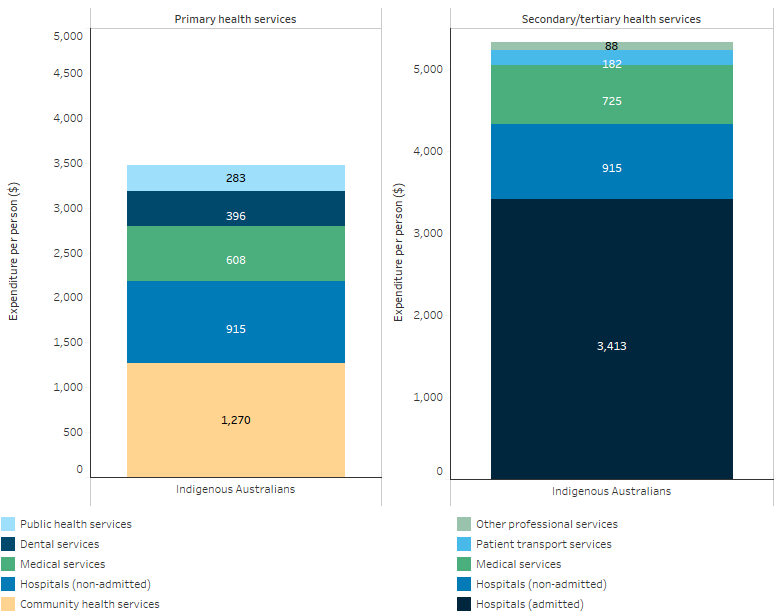
Note: Expenditure on medications by Indigenous status is not currently available and as such has been removed from totals. Ordinarily, this would includes funding for the Pharmaceutical Benefits Scheme, Repatriation Pharmaceutical Benefits Scheme and other pharmaceutical related funding.
Source: Table D3.21.6. AIHW Health Expenditure Database.
Expenditure on hospital separations
In 2019–20, total expenditure on hospitalisation separations (when a diagnosis was recorded) was $3,334 million for Indigenous Australians, equating to $3,905 per person.
For Indigenous Australians, expenditure was highest for mental and behavioural disorders ($508 per person), followed by injury, poisoning and other external causes ($423 per person) (Table D3.21.10, Figure 3.21.5).
Figure 3.21.5: Expenditure per person on hospital separations in public and private hospitals for Indigenous Australians, by disease group, 2019–20
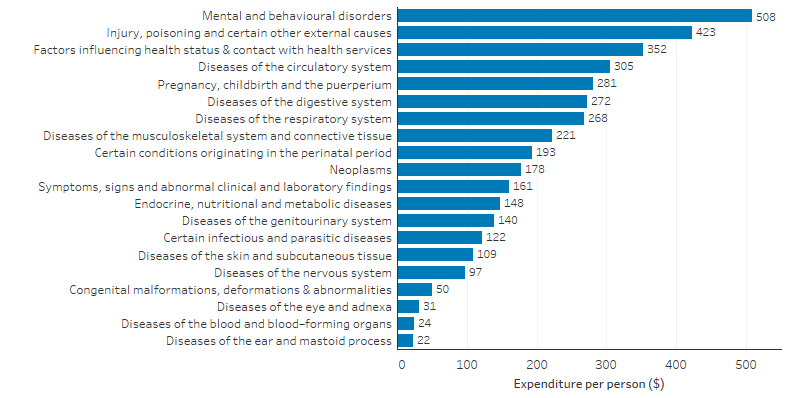
Source: Table D3.21.10. AIHW Health Expenditure Database.
In 2019–20, total expenditure for Indigenous Australians for potentially preventable hospital admissions was $426 million. This equated to $499 per person, including:
- $204 per person for chronic conditions,
- $183 per person for acute conditions, and
- $112 per person for vaccine-preventable conditions (Table D3.21.11).
Comparisons with non-Indigenous Australians
Total health expenditure
In 2019–20, the average health expenditure per person for Indigenous Australians was estimated to be $9,619, which was $1.50 for every $1 spent per person for non-Indigenous Australians. Of this, $5,244 (55%) was spent on hospital services. For non-Indigenous Australians, the average health expenditure per person was estimated to be $6,473 (Table D3.21.1).
During 2019–20, an estimated 81% of the total funding used to pay for health-related goods and services for Indigenous Australians was funded by governments, compared with 75% for non-Indigenous Australians (Table D3.21.2).
Expenditure on Medicare Benefits Schedule
Nationally, in 2019–20, MBS expenditure for Indigenous Australians was 1.2 times that of non-Indigenous Australians ($1,176 and $978 per person, respectively). Across remoteness areas, the gap was largest in Remote and very remote areas where expenditure for Indigenous Australians was 1.8 times that of non-Indigenous Australians ($1,545 and $872 per person, respectively) (Table D3.21.8).
Primary and secondary/tertiary health services
In 2019–20, for Indigenous Australians, expenditure for primary health care services was $3,887 per person, compared with $2,055 per person for non-Indigenous Australians, at a ratio of 1.9 times. Expenditure for secondary/tertiary health care services (mainly hospital services) was $5,347 per person for Indigenous Australians, compared with $3,951 for non-Indigenous Australians (at a ratio of 1.4 times) (Table D3.21.6).
Primary health care expenditure on medical services, including those paid through the MBS, was $608 per person for Indigenous Australians, compared with $382 for non-Indigenous Australians (at a ratio of 1.6 times). Expenditure on community health services for Indigenous Australians was 3.5 times the rate than for non-Indigenous Australians ($1,270 compared with $367 per person) (Table D3.21.6).
Expenditure on hospital separations
In 2019–20, expenditure on hospitalisation separations per person was higher for Indigenous Australians than non-Indigenous Australians in almost all diagnosis categories, with the highest differences for:
- mental and behavioural disorders ($508 per person compared with $201 per person),
- factors influencing health status and contact with health services (for example, examinations) ($352 per person compared with $181 per person),
- certain conditions originating in the perinatal period ($193 per person compared with $49 per person),
- pregnancy, childbirth and the puerperium ($281 per person compared with $145 per person),
- injury, poisoning and other external causes ($423 per person compared with $291 per person), and
- respiratory diseases ($268 per person compared with $138 per person).
However, expenditure for Indigenous Australians was lower than for non-Indigenous Australians for treatment of musculoskeletal and connective tissue disorders ($221 per person compared with $305 per person), neoplasms (including cancer; $178 per person compared with $266 per person) and diseases of the eye and adnexa ($31 per person compared with $74 per person) (Table D3.21.10).
Expenditure on potentially preventable hospitalisations totalled $499 per person for Indigenous Australians, compared with $208 per person for non-Indigenous Australians. For expenditure on potentially preventable hospitalisations, the greatest difference is attributable to diabetes (a gap of $48 per person), chronic obstructive pulmonary disease (a gap of $33 per person), influenza and pneumonia (a gap of $28 per person), convulsions and epilepsy (a gap of $23 per person) and cellulitis (a gap of $20 per person) (Table D3.21.11).
Health service usage patterns
In 2019–20, for Indigenous Australians, expenditure on hospital services was 3.9 times the expenditure for medical services (for example, MBS services provided by a medical practitioner), compared with 2.4 times for non-Indigenous Australians (Table D3.21.1). This reflects different service usage patterns and costs.
In the same year, funding per person for community health services for Indigenous Australians was 3.5 times the amount for non-Indigenous Australians ($1,270 per person compared with $367 per person). Funding for Indigenous Australians for public health services was 2.1 times the amount for non-Indigenous Australians ($283 per person compared with $137 per person) (Table D3.21.12).
Changes over time
Australian Government and state/territory governments expenditure
From 2010–11 to 2019–20, Australian Government health expenditure per person for Indigenous Australians increased by 7.3% per annum in real terms, from $2,269 per person to $4,295 per person. In 2019–20, the Australian Government spent 21% ($919 per person) of the total health expenditure on Indigenous (ACCHS) services, and 13% ($569 per person) on medical treatment through the MBS (Table D3.21.4, Figure 3.21.6).
From 2010–11 to 2019–20, state and territory government health expenditure per person for Indigenous Australians increased by 6.4% per annum in real terms, from $3,042 per person to $5,328 per person. Community health or public health service was the area of expenditure with the highest rate of growth for state and territory government funding. It grew by 13% annually in real terms, from $341 to $1,004 per person for Indigenous Australians (Table D3.21.4, Figure 3.21.6).
Figure 3.21.6: Australian Government and state/territory governments health expenditure per person for Indigenous Australians, 2010–11 to 2019–20 (constant prices)
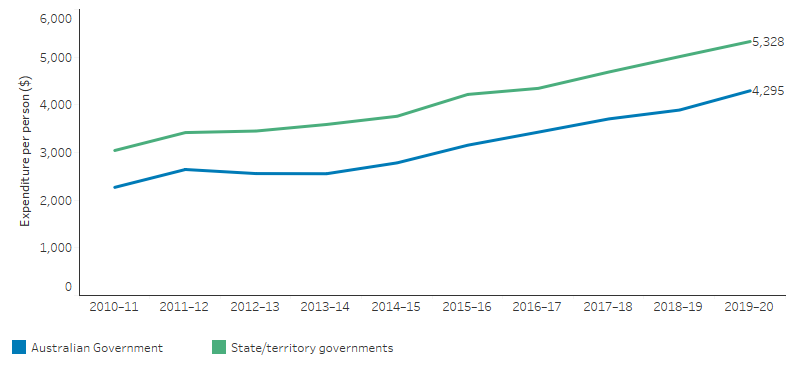
Note: Expenditure on medications by Indigenous status is not currently available and as such has been removed from totals. Ordinarily, this would includes funding for the Pharmaceutical Benefits Scheme, Repatriation Pharmaceutical Benefits Scheme and other pharmaceutical related funding.
Source: Table D3.21.4. AIHW Health Expenditure Database.
Australian Government expenditure on Indigenous-specific health programs
For health services tailored to the needs of Indigenous Australians, the Australian Government allocated $972 million on Indigenous-specific health program expenditure through the Department of Health in 2019–20, an increase from $703 million in 2010–11 (38% increase) (Figure 3.21.7). In real terms, expenditure increased $716 to $923 million, an increase of 29% (Table D3.21.9).
Figure 3.21.7: Expenditure by the Australian Government on Indigenous-specific health programs, 2010–11 to 2019–20 (current prices)
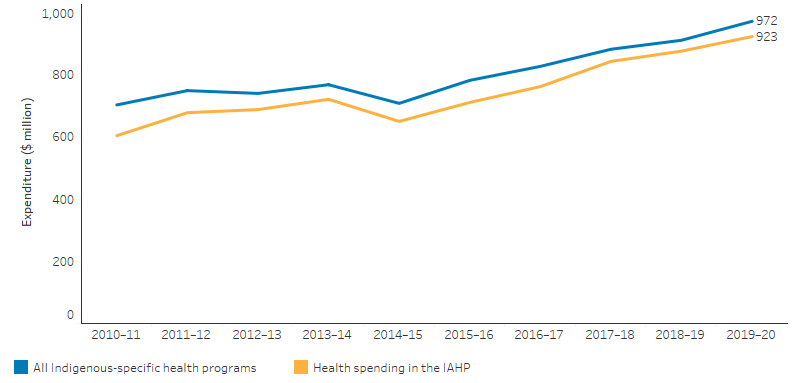
Source: Table D3.21.9. AIHW analysis of Department of Health and Aged Care cost centres.
Research and evaluation findings
Australia was the first country to comprehensively estimate how much was spent on health services for its Indigenous population. A report published in 1998, estimated that per person health expenditure from all sources for Indigenous people in 1995–1996 was 8% higher than for non-Indigenous people. As the health status of Indigenous people was much worse than for non-Indigenous people, with a life expectancy gap of at least 12 years, it was clear that the 8% higher per person expenditure was not enough to address the much greater need for health services of Aboriginal and Torres Strait Islander people (Deeble et al. 1998; Goss 2022). Indigenous health expenditure estimates have continued to be refined over the years (AIHW 2008), including estimates being made of Indigenous health expenditure by remoteness and by disease (AIHW 2013a).
Research has shown that those on lower incomes rely more on publicly provided services and spend less money on private hospital services than people with higher incomes, and are much more likely to present to hospitals, even for primary health care (Deeble 2009).
Evidence suggests that the higher expenditures in rural and remote areas are largely related to hospital services and grants to Indigenous health services, and partly reflects higher costs of delivering health care services in those areas (AIHW 2013b).
Data shows that government health funding is critically important for funding health care to Indigenous Australians. Australian governments provide 78% of all Indigenous Australian health expenditure, compared with 70% for non-Indigenous Australians. Indigenous Australians rely on and need government financial support for a strong community health sector (AIHW 2020).
Evidence indicates that up to two-thirds of Indigenous Australians rely on Indigenous-specific primary health care services. Yet, three-quarters of all government Indigenous health expenditure is on mainstream services, and nearly half (48.4%) of all expenditure is on hospitals (Alford 2014; SCRGSP 2012). This can partly be explained by greater intensity of service use (more services per capita because of greater need), plus additional costs of providing mainstream services to Indigenous Australians, for reasons such as location, culture and language. There are also costs for Indigenous-specific services that complement mainstream services, for example, Indigenous liaison officers in hospitals (SCRGSP 2012).
Chronic diseases are major contributors to the gap in life expectancy between Indigenous and non-Indigenous Australians. The Australian government implemented the Closing the Gap PBS Co-payment Measure in 2010 to reduce prescription drug co-payments and thereby improve access to PBS medicines for Indigenous Australians with chronic diseases or risk factors of chronic diseases. Eligible patients could register at participating general practices or ACCHS clinics. Among registered patients, the incentive reduced co-payments from $33.30 per prescription to about $5.40 per prescription (price adjusted) for non-concessional patients. The co-payment of $5.40 was eliminated for concessional patients. The reduction of co-payment increased the use of medications for both concessional and non-concessional patients (Trivedi & Kelaher 2020). Previous economic evaluation studies on removing out-of-pocket costs for prescriptions for patients who have had a myocardial infarction have suggested that reducing medication co-payment could improve adherence to treatment and reduce serious complications, therefore, improving health outcomes without necessarily increasing the total expenditure on health care in the longer term (Choudhry Niteesh K. et al. 2011; Choudhry N. K. et al. 2014).
A data-linkage study of the Queensland population showed that large out-of-pocket costs associated with health care are a significant barrier to equitable access. Indigenous Australians with cancer in Australia pay significantly less on co-payments for services covered under Medicare than non-Indigenous people with cancer in the first 3 years after diagnosis. The difference could be explained by the fact that Indigenous people with cancer were less likely to access services covered by Medicare, such as pathology tests, diagnostic imaging, as well as specialists, and radiotherapy and therapeutic nuclear medicine services. It was also possible that they may have accessed these services through state and territory funded programs, and therefore, could not be captured in the study data. In order to account for these differences in access patterns, researchers conducted additional modelling of the scenario and found that if Indigenous people had the same rate of access to services covered under Medicare as non-Indigenous people, they would incur much higher out of pocket expenditure for co-payments. The findings suggest that although Australia's universal health care policies are supporting equity, there is still substantial inequity in terms of access to services for Indigenous people with cancer. However, the study has limitations, including the limited costs included and the inability to adjust for co-morbidities and educational level (Callander et al. 2019).
Another data-linkage study analysed MBS and PBS expenditure between 2010–11 and 2019–20 by state and territory, remoteness, and Indigenous demography to assess funding equality in meeting the health needs of remote Indigenous populations in the Northern Territory (Zhao et al. 2022). The data have shown that the Northern Territory receives the lowest per-capita payments from MBS and PBS, despite its greater remoteness and health needs (Zhang et al. 2018). The unmet needs were potentially due to the unique primary health care model in remote areas. Unlike mainstream primary health care in Australia, which is general practice, remote primary health care delivery is primarily led by Aboriginal Health Practitioners and Remote Area Nurses who provide first contact care. However, some of these services fall outside MBS eligibility criteria, posing significant cost to patients. Additional barriers such as health literacy, language and cultural barriers to communication, and limited access to transportation deter residents of remote areas from utilising health care services. Initiatives such as the Commonwealth health financing reforms, for example Health Care Homes, which provide blended payment for team-based care, are highly relevant to the Northern Territory but will need to be calibrated to reflect the service delivery in remote and very remote settings (Australian Government Department of Health 2019).
The Australian Government Department of Health’s Indigenous Australians’ Health Programme (IAHP) Economic Evaluation Phase One was published in mid-2018. It focused on the return on investment of the IAHP as measured by potentially preventable hospitalisations and the relative costs of Indigenous-specific compared with non-Indigenous specific primary health care service. The report showed that higher attendance at ACCHSs reduced the likelihood of hospital admission, as well as providing health gains. While the provision of care through mainstream services may be cheaper, it is likely to be associated with worse health outcomes due to less comprehensive and integrated care that may not be culturally competent and may not meet patients’ needs and expectations. These findings were used to demonstrate the cost-effectiveness of ACCHSs, although there were some methodological limitations. For more information, see measure 1.24 Avoidable and preventable deaths (Dalton & Carter 2018).
A systematic review on the scope and quality of economic evaluations of Aboriginal and Torres Strait Islander health programs concluded that “despite significant investment in strategies to close the gap in health outcomes for Aboriginal and Torres Strait Islander people, there is limited evidence about what constitutes a cost-effective investment in Aboriginal and Torres Strait Islander health care” (Doran C et al. 2022).
In 2017, the Australian Government announced it was undertaking a national evaluation of its investment in Aboriginal and Torres Islander primary health care which occurs primarily through the IAHP. The evaluation has a whole of system, person-centred approach that not only focuses on the appropriateness and effectiveness of the IAHP, but its interactions and influence on other parts of the primary health care and wider health system. It is drawing on the perspectives of Aboriginal and Torres Strait Islander stakeholders at different levels of the system and aims to facilitate learning across these levels. The Department of Health and Aged Care is working with the IAHP Yarnes Health Sector Co-design Group on finalising the evaluation in 2024.
A 2014 independent report commissioned by the National Aboriginal Community Controlled Health Organisation (NACCHO) was the first detailed health economics study of ACCHSs and related resource and funding issues in Australia. The report included an assessment and evaluation of the economic and health value derived from the ACCHS sector and an evaluation of government policy and expenditure on ACCHSs and Indigenous health more generally. The report also investigated any additional cross-sector benefits to the Australian economy provided by ACCHSs such as employment, economic independence and education. The report asserted that as Indigenous Australians comprise 3% of the Australian population and have a relative need of at least twice the rest of the population because of much higher levels of illness, it is important for funding to be more commensurate with need and be better distributed (Alford 2014).
NACCHO, in partnership with Equity Economics, undertook an analysis of the gap in health expenditure for Aboriginal and Torres Strait Islander people. This report concludes that there remains a large and persistent gap in expenditure on health care for Aboriginal and Torres Strait Islander people given the additional need (NACCHO & Equity Economics 2022).
Implications
Issues of equity are particularly important in this performance measure. The understanding of equity must also acknowledge that the conceptual construct of health is different for Indigenous Australians from non-Indigenous Australians and therefore the outcomes sought may be different (Mooney 2003).
There are a number of aspects of access to care that relate to health inequities and need to be recognised in analysing health expenditure per person. These aspects of geography, discrimination, affordability and availability are dealt with in detail in measure 3.14 Access to services compared with need. These are issues that affect equity and quality of care and the level of need for health care of Indigenous Australians.
The National Aboriginal and Torres Strait Islander Health Plan 2021-2031 (Health Plan) recognises that First Nations peoples must have access to culturally safe and responsive care to ensure long and healthy lives. It also recognises that key mainstream health system changes are required, including:
- Identifying and eliminating racism
- Ensuring access to person-centred and family-centred care
- Trauma-aware and healing-informed approaches
- Building the First Nations health workforce
- Holistic health promotion, prevention and early intervention
The Health Plan recognises this type of care is best delivered by the community-controlled sector, and outlines partnerships with the sector as fundamental to mainstream service improvement.
The National Agreement on Closing the Gap also recognises the First Nations’ community-controlled health service sector as best-placed to deliver culturally safe care that is responsive to the priorities of First Nations peoples. A 3-year Health Sector Strengthening Plan (Health-SSP) was released in 2021 under the National Agreement. It was developed in genuine partnership with the First Nations’ community-controlled health sector and other First Nations’ health organisations to include 17 transformative sector strengthening actions, that respond to key challenges for the sector.
An additional issue to consider when interpreting per capita expenditure is the degree of variation between the jurisdictions. Variations in expenditure by jurisdiction will be influenced by a range of factors, including the additional costs of delivering services in remote areas, the size of the Indigenous Australian population in remote areas and differences in health needs, health services and health structures. Australia’s constitution and intergovernmental financial transfer arrangements result in differences between the funding and expenditure levels in jurisdictions.
Data on health expenditure by smaller areas of geography would be particularly useful as other health data by smaller geographies become increasingly available. This will aid an understanding of the extent of unmet health need for Indigenous Australians and will help to better target areas of greatest need.
Investing $1 in primary care in remote Aboriginal and Torres Strait Islander communities was found to save $3.95–$11.75 in hospital costs, in addition to benefits for individual patients. High levels of primary care utilisation were associated with decreases in avoidable hospitalisations, deaths and years of life lost (Zhao et al. 2014). More research is required into the cost-effectiveness of ACCHSs to provide evidence for advantages, health gains and strategies that improve health outcomes (Dalton & Carter 2018), as well as gaps and barriers that need to be addressed (Alford 2014).
The policy context is at Policies and Strategies.
References
-
AIHW (Australian Institute of Health and Welfare) 2008. Expenditures on health for Aboriginal and Torres Strait Islander peoples 2004–05. Health and welfare expenditure series no. 33. Cat. no. HWE 40. Canberra: AIHW.
-
AIHW 2013a. Expenditure on Health for Aboriginal and Torres Strait Islander People 2010–11: An Analysis by Remoteness and Disease. Canberra: AIHW.
-
AIHW 2013b. Expenditure on health for Aboriginal and Torres Strait Islander People 2010–11. Canberra: AIHW.
- AIHW 2020. Expenditure on Aboriginal and Torres Strait Islander health, 2015-16, unpublished. Canberra.
-
AIHW 2023. Health expenditure. Canberra: AIHW. Viewed 1 June 2023.
- Alford K 2014. Economic value of aboriginal community controlled health services.
- Alford K 2015. Indigenous health expenditure deficits obscured in Closing the Gap reports. The Medical Journal of Australia 203:403.
- Australian Government Department of Health 2019. Health Care Homes: handbook for general practices and Aboriginal Community Controlled Health Services. Canberra: Australian Government Department of Health.
- Braveman P & Gruskin S 2003. Defining equity in health. Journal of Epidemiology and Community Health 57:254-8.
- Callander E, Bates N, Lindsay D, Larkins S, Topp SM, Cunningham J et al. 2019. Long-term out of pocket expenditure of people with cancer: comparing health service cost and use for indigenous and non-indigenous people with cancer in Australia. Int J Equity Health 18:32.
- Choudhry NK, Avorn J, Glynn RJ, Antman EM, Schneeweiss S, Toscano M et al. 2011. Full Coverage for Preventive Medications after Myocardial Infarction. New England Journal of Medicine 365:2088-97.
- Choudhry NK, Bykov K, Shrank WH, Toscano M, Rawlins WS, Reisman L et al. 2014. Eliminating medication copayments reduces disparities in cardiovascular care. Health Aff (Millwood) 33:863-70.
- Dalton A & Carter R 2018. Economic Evaluation of the Indigenous Australians’ Health Programme Phase I.
- Deeble J 2009. Assessing the health service use of Aboriginal and Torres Strait Islander peoples. Canberra: NHHRC.
- Deeble J, Mathers C, Smith J & Goss J 1998. Expenditures on Health Services for Aboriginal and Torres Strait Islander People. Canberra, Australia: Public Affairs, Parliamentary and Access Branch, Commonwealth Department of Health and Family Services.
-
Goss J 2022. Health Expenditure Data, Analysis and Policy Relevance in Australia, 1967 to 2020. Int J Environ Res Public Health:14;9(4):2143.
- Mooney G 2003. Here's a recipe for a more equitable health care system in Australia. Online Opinion.
-
NACCHO (National Aboriginal Community Controlled Health Organisation) & Equity Economics 2022. Measuring the Gap in Health Expenditure: Aboriginal and Torres Strait Islander Australians.
- SCRGSP (Steering Committee for the Review of Government Service Provision) 2012. Indigenous Expenditure Report 2012. Canberra: Productivity Commission.
- Trivedi AN & Kelaher M 2020. Copayment Incentive Increased Medication Use And Reduced Spending Among Indigenous Australians After 2010: A study of government-sponsored subsidies to reduce prescription drug copayments among indigenous Australians. Health Affairs 39:289-96.
- Whitehead M 1991. The concepts and principles of equity and health. Health Promotion International 6:217-28.
- Zhang X, Zhao Y & Guthridge S 2018. Burden of disease and injury study: Impact and causes of illness, injury and death in the Northern Territory 2004-2013. Darwin: Department of Health.
- Zhao Y, Thomas S, Guthridge S & Wakerman J 2014. Better health outcomes at lower costs: the benefits of primary care utilisation for chronic disease management in remote Indigenous communities in Australia's Northern Territory. BMC health services research 14:463.
-
Zhao Y, Wakerman J, Zhang X, Wright J, VanBruggen M, Nasir R et al. 2022. Remoteness, models of primary care and inequity: Medicare under-expenditure in the Northern Territory. Australian Health Review 46:302-8.

